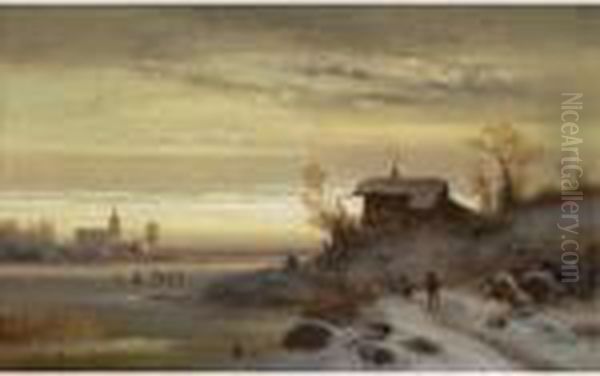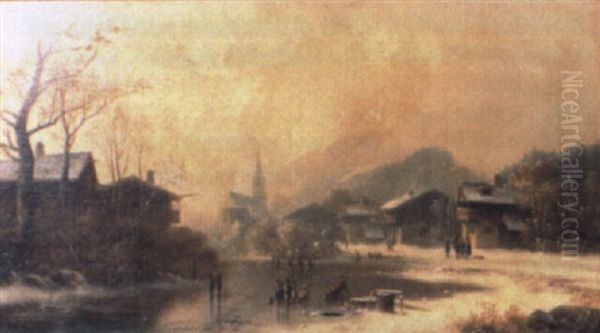Anton Doll stands as a notable figure in 19th-century German art, particularly cherished for his evocative depictions of Munich and its surrounding Bavarian landscapes. Born in Munich in 1826 and passing away in the same city in 1887, Doll dedicated his artistic career to capturing the essence of his homeland, with a special affinity for winter scenes and architectural views. His work provides a valuable window into the life and atmosphere of Munich during a period of significant cultural development.
Early Life and Artistic Beginnings
Anton Doll's journey into the world of art was not immediate. Born into the bustling city of Munich, his initial academic pursuits led him to study law. However, the allure of the visual arts proved stronger than jurisprudence. Doll eventually abandoned his legal studies, choosing instead to follow his passion for painting, a decision that would shape the rest of his life and contribute significantly to the Munich art scene of his time.
His commitment to his new path was solidified in 1852 when he became an official member of the prestigious Munich Art Association (Münchner Kunstverein). This membership was not merely a formality; it marked his integration into the city's active artistic community. From very early in his association membership, Doll began exhibiting his works, sharing his unique vision with the public and his peers. This regular participation in exhibitions helped establish his reputation as a dedicated and skilled painter.
Artistic Style and Influences
Doll's artistic style is deeply rooted in the traditions of landscape painting, yet possesses a distinct character. He drew significant inspiration from the Dutch Old Masters of the 17th century, particularly their mastery of light, atmosphere, and detailed depiction of daily life within landscape settings. This influence is evident in the meticulous rendering and atmospheric quality found in many of Doll's works, especially his winter scenes which often echo the compositions of artists like Hendrick Avercamp or Aert van der Neer.

However, Doll was not merely an imitator. He adapted these influences to his own environment and time, infusing his paintings with elements of German Romanticism, which emphasized emotion, individuality, and the sublime beauty of nature. His work often carries a sense of nostalgia and quiet contemplation. His brushwork is typically described as delicate and precise, allowing for detailed portrayals of architecture, figures, and the subtle textures of snow and ice.
Within the Munich art scene, Doll was also shaped by local contemporaries and predecessors. His development was notably influenced by painters like Carl August Lebsché, known for his architectural views, and Adolf Stademann, another Munich artist specializing in atmospheric winter landscapes. These connections place Doll firmly within the context of the Munich School, a significant movement in German art during the 19th century, known for its realism and painterly techniques, although Doll retained a more romantic, Biedermeier sensibility in many works.
Key Themes and Subjects
Anton Doll's oeuvre is characterized by a consistent focus on specific themes and subjects, primarily centered around his native Munich and the Bavarian countryside. He is perhaps best known for his captivating winter landscapes. These scenes often depict snow-covered villages, frozen rivers or lakes bustling with skaters, and the quiet solitude of the countryside under a blanket of snow. He masterfully captured the unique light and atmosphere of the winter months.
Munich itself was a recurring subject. Doll painted numerous cityscapes, documenting the architectural face of the Bavarian capital. These works often focused on well-known landmarks but also captured the charm of everyday street scenes and hidden corners. His interest extended to historical buildings, which he rendered with accuracy and a sense of their enduring presence, reflecting a romantic appreciation for the past.
Beyond the urban environment, Doll frequently ventured into the nearby Alpine foothills and rural villages. Places like Weindorf appear in his work, depicted with scenes of local life, such as cattle farming or villagers going about their daily activities. These paintings showcase his keen observation skills and his ability to blend genre elements seamlessly into his landscapes, creating lively and engaging compositions.
Representative Works

Several works stand out as representative of Anton Doll's artistic output and thematic concerns. One frequently cited painting is often referred to as "Figures in a Winter Landscape" or similar titles capturing winter village life. Descriptions match a scene set in a misty Alpine village, featuring a frozen lake or foreground area where children are skating. The composition includes snow-laden slopes, traditional farmhouses with stone roofs, perhaps a sleigh, and various small figures animating the landscape, showcasing his skill in combining landscape and genre elements.
Another known title is "Partie bei Kastelbell" (Scene near Kastelbell), indicating his travels and interest in depicting specific locations, likely in the South Tyrol region which was popular among Munich artists. Works simply titled "Skaters" or "Winter Landscape" also frequently appear, underscoring his dedication to these signature themes. A painting titled "Cattle Scene in Weindorf" highlights his engagement with rural Bavarian life. These works collectively demonstrate his focus on atmospheric landscapes, often populated with figures enjoying leisure activities or engaged in rural work, rendered with his characteristic detailed style.
The Munich School and Contemporaries
Anton Doll worked during a vibrant period for art in Munich. The city was a major European art center, home to the influential Munich School, which emphasized naturalism, painterly techniques, and often depicted genre scenes or landscapes. While Doll shared the geographical location and some thematic interests (like landscape), his style retained a connection to the earlier Biedermeier period's intimacy and detail, distinguishing him from the bolder realism of some contemporaries.
His artistic environment included a diverse range of painters. Figures like Eduard Schleich the Elder were leading landscape painters in Munich, known for their atmospheric depictions of the Bavarian plains. Carl Spitzweg, a master of Biedermeier genre painting, captured the quirky and intimate side of Munich life. Adolf Lier brought influences from the French Barbizon school to Munich landscape painting.
Other major figures active in Munich during parts of Doll's lifetime included the celebrated portraitist Franz von Lenbach, the historical painter and academy director Wilhelm von Kaulbach, and the Romantic painter Moritz von Schwind. Earlier influential figures like Peter von Cornelius (Nazarene movement) and Leo von Klenze (architect and painter) had shaped the city's neoclassical artistic foundations. Landscape painters like Carl Rottmann, known for his heroic Greek and Italian scenes, also contributed to Munich's artistic fame. Even later realists like Wilhelm Leibl, though representing a different direction, were part of the broader Munich art world. Doll navigated this rich environment, maintaining his focus on detailed, often idyllic or atmospheric, views of his homeland.
Exhibitions and Recognition
Anton Doll's dedication to his craft was matched by his active participation in the art world. As a member of the Munich Art Association from 1852, he was a regular exhibitor at their shows. This provided him with a consistent platform to present his work to the public, critics, and potential patrons. His paintings gained recognition and were acquired by important public collections.
Notably, his works found homes in Munich's Neue Pinakothek, one of Germany's foremost galleries for 19th-century art, and the Staatsgalerie (likely the Bavarian State Painting Collections, of which the Neue Pinakothek is part). The inclusion of his work in such prestigious institutions speaks to the esteem in which he was held during his lifetime and subsequently.
Beyond public collections, Doll's paintings were popular with private collectors. His appealing subject matter – charming city views, picturesque landscapes, and lively winter scenes – resonated with the tastes of the burgeoning middle class and aristocracy. His name also appears in significant art historical references, such as the Thieme/Becker artist lexicon, confirming his established place in German art history. The mention of a letter regarding sending a work to Vienna for exhibition further indicates his engagement with the wider art circuit beyond Munich.
Legacy and Historical Evaluation
Anton Doll's legacy lies primarily in his role as a visual chronicler of Munich and its environs during the mid-to-late 19th century. He captured the specific character of the Bavarian capital and the beauty of its surrounding landscapes, particularly during winter, with a sensitivity and detail that continue to appeal. His work offers a glimpse into a specific time and place, rendered with technical skill and a gentle, often romantic, sensibility.
While perhaps not as revolutionary as some of his contemporaries, Doll holds a secure place within the tradition of German landscape and architectural painting. His ability to blend the detailed observation influenced by Dutch masters with the atmospheric mood of Romanticism resulted in a distinctive and enduring style. He successfully catered to the tastes of his time while creating works of genuine artistic merit.
Historically, he is evaluated as a significant painter within the Munich School context, albeit representing a slightly more conservative or Biedermeier-influenced vein compared to the burgeoning realism of others. The continued presence of his works in major museum collections and their performance at art auctions attest to his lasting recognition. He remains appreciated for his skillful technique, his evocative portrayal of Bavarian scenes, and his contribution to the rich tapestry of 19th-century German art.
Conclusion
Anton Doll was a dedicated and talented German painter whose life and work were intrinsically linked to his native Munich. Forsaking law for art, he became a respected member of the Munich Art Association and a prolific painter of landscapes, cityscapes, and architectural views. Deeply influenced by Dutch Old Masters yet imbued with a German Romantic spirit, he excelled at capturing the atmospheric beauty of Bavaria, especially its winter landscapes. Through works like "Figures in a Winter Landscape" and numerous views of Munich, Doll created a lasting visual record of his homeland, securing his position as an important regional painter within the broader context of 19th-century European art. His paintings continue to be admired for their detail, charm, and evocative power.